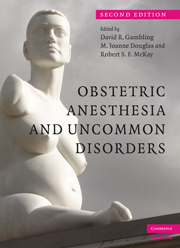Book contents
- Frontmatter
- Contents
- List of plates
- List of contributors
- Preface
- Section 1 Cardiovascular and respiratory disorders
- Section 2 Musculoskeletal disorders
- Section 3 Nervous system disorders
- Section 4 Metabolic disorders
- 13 Disorders of intermediary metabolism
- 14 Liver and renal disease
- 15 Malignant hyperthermia
- 16 Rare endocrine disorders
- Section 5 Other disorders
- Index
- Plate Section
- References
14 - Liver and renal disease
from Section 4 - Metabolic disorders
Published online by Cambridge University Press: 19 October 2009
- Frontmatter
- Contents
- List of plates
- List of contributors
- Preface
- Section 1 Cardiovascular and respiratory disorders
- Section 2 Musculoskeletal disorders
- Section 3 Nervous system disorders
- Section 4 Metabolic disorders
- 13 Disorders of intermediary metabolism
- 14 Liver and renal disease
- 15 Malignant hyperthermia
- 16 Rare endocrine disorders
- Section 5 Other disorders
- Index
- Plate Section
- References
Summary
Liver disease
Effects of pregnancy on the liver
Pregnancy induces anatomic, physiologic, and functional changes in the liver because of an increase in serum estrogen and progesterone. These changes reverse postpartum, but can cause diagnostic difficulties during pregnancy if liver disease is present. For example, spider nevi and palmar erythema are stigmata of liver disease, but may be seen in some pregnant women in response to increased estrogen levels.
In normal pregnancy, liver size does not change significantly so hepatomegaly suggests liver disease. Hepatic blood flow remains unchanged, despite the physiologic increase in blood volume and cardiac output. In fact, the portion of cardiac output delivered to the liver falls by 35%. There is increased splanchnic, portal, and esophageal venous pressure in late pregnancy, and 60% of healthy women will develop esophageal varices that resolve postpartum. Clearance of drugs dependent on hepatic blood flow is reduced because of a larger volume of distribution.
Serum albumin concentration falls by up to 60% secondary to an increase in plasma volume, leading to a fall of total serum protein by 20% in mid-pregnancy. Serum globulins alter slightly, with an increase in α and β fractions, and α-fetoprotein concentration, but a reduction in γ-globulin. There is increased production of fibrinogen and factors VII, VIII, IX, X and von Willebrand factor. Ceruloplasmin and transferrin levels increase, as do several specific binding proteins (e.g. thyroxine, vitamin D, and corticosteroids). There are minor changes in porphyrin metabolism.
- Type
- Chapter
- Information
- Obstetric Anesthesia and Uncommon Disorders , pp. 249 - 268Publisher: Cambridge University PressPrint publication year: 2008
References
- 2
- Cited by



